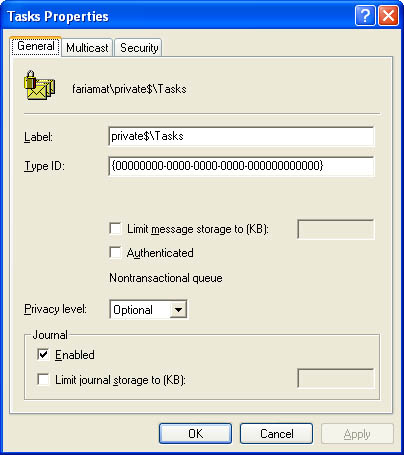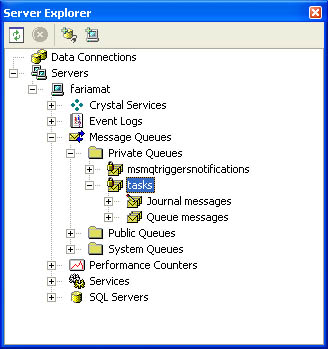Message Queuing Basics
| Database products such as Microsoft SQL Server divide information into multiple databases that contain multiple tables. Message queues separate information into distinct queues that are usually associated with different operations or tasks. For example, an e-commerce program might read order information from a ProductOrders queue, and a data-mining component might read from a RequestedTasks queue. By default, all queues are stored in the directory C:\[Windows Dir]\System32\Storage of the host computer. Outgoing messages that haven't yet been sent might be stored in memory or they might also be found in the Storage directory on the sending computer, depending on the requested transmission method. Figure 8-1 shows a simplified diagram of Message Queuing. Figure 8-1. Message transmission with Message Queuing Types of Message QueuesTo perform its work, Message Queuing requires several types of message queues. The following sections introduce each one briefly. Public QueuesPublic queues are published in an Active Directory listing and are replicated across a Windows 2000 domain. You can browse or search for a public queue without knowing the name of the computer that hosts it (and therefore you can also move a queue from one computer to another without affecting the client). Private QueuesPrivate queues can be used in a workgroup environment without a dedicated Message Queuing server, they don't support authentication, and they can't be located without the computer name. These queues are used most often for development testing before a full deployment or for small-scale use. Outgoing QueuesOutgoing queues are local internal queues that are used to store messages before they are sent to the destination (remote) queue. Messages can be stored for long periods of time in an outgoing queue if the computer is off line, and they will be automatically sent when connectivity is reestablished. Outgoing queues are generated automatically and can't be created or deleted manually. Connector QueuesConnector queues reside on Message Queuing servers. They act as a proxy for queues provided by other computers and managed by other messaging systems. For example, you can use Microsoft's MSMQ-MQSeries Bridge (included with the Host Integration Server 2000 product), which allows your .NET applications to interact with IBM MQSeries queues. Similarly, you can use the Microsoft Message Queuing Connector (MQC), which allows connectivity with computers running Message Queuing on non-Windows-based platforms such as UNIX or AS/400. Connector queues handle message transition seamlessly and allow an application to use a foreign queue in the same way it uses an ordinary Message Queuing queue. Without connector queues, there is no interoperability between different Message Queuing products. Journal QueuesJournal queues contain copies of messages that have been sent or processed, for future reference. There are two types of journaling: source and target. When sending a message, the sender can elect to use journaling to store a copy of the message on the current computer. Source journaling is therefore controlled on a per-message basis. Target journaling is set on a per-queue basis. If a destination queue has journaling enabled, it stores a copy of every message it receives in a separate journal queue. Dead-Letter QueuesDead-letter queues contain messages that expired without being successfully delivered. In some cases, the message might have expired after being forwarded to another computer (or even arriving at the target), in which case it is placed in the dead-letter queue of the computer where it was when it expired. Messages for transactional queues (discussed later in this chapter) are stored in a separate transactional dead-letter queue. What makes a message undeliverable? A number of factors can intervene, including the following:
Administration QueuesAdministration queues just store acknowledgement messages (for example, messages that confirm that another message was received). They shouldn't be confused with internal private queues, which Message Queuing uses behind the scenes to manage other queues and record diagnostic information. This chapter does not discuss internal queues. Report QueuesThe report queue is used to track the route a sent message takes if message route tracking is enabled. There can only be one report queue per computer. The Message Queue ServiceIf you're new to Message Queuing, you're probably wondering about the underlying technology that drives it. Basically, Message Queuing uses a Windows service to dispatch and receive messages. You can find the service listed, like all others, in the Computer Management utility (as shown in Figure 8-2). This service actually has a fair bit of responsibility, including reading from queues, writing to queues, and working across the network with other Message Queuing services to route messages to their destination. Figure 8-2. The Message Queuing service Configuring Message QueuesYou can perform every Message Queuing task, including creating and removing queues, from a .NET application. In the majority of cases, however, you will create your queues manually with the Computer Management tool and then use .NET code just for sending messages. This is much the same way you would use a server-side database. You can configure queues by expanding the Message Queuing node under the Services And Application node. You can right-click on a queue category folder to create a new queue for your application. You'll be prompted to enter a queue name and indicate whether the queue is transactional. Transactional queues ensure that messages arrive in the same order they were sent (and hence the message priority is ignored). Transactional queues also guarantee that messages arrive only once. Transactional message queues do not enlist the message sending and message receiving into a single atomic operation, as you might assume. Even with transactional queues, Message Queuing uses a disconnected model in which send and receive operations are decoupled from one another. After creating a queue, you can right-click and modify its properties (as shown in Figure 8-3). Figure 8-3. Message queue properties The options you can configure include the following:
Finally, it's worth noting that you can perform all the same tasks for creating and managing queues using the Server Explorer window in Visual Studio .NET (as shown in Figure 8-4). Figure 8-4. Configuring queues in Visual Studio .NET The Anatomy of a MessageSo far we've defined message queues as message lists, but we haven't really considered what a message contains. Every Message Queuing message consists of a few basic properties, such as a label (the title of the message), a priority (which determines the order in which the receiving application reads the messages, assuming they are nontransactional), and the body (which contains the actual message content). The message body is not limited to textual data. Instead, it can include any type of data formatted using binary or XML encoding. However, the recipient application assumes the responsibility of recognizing and reconstructing the appropriate object based on the message data. .NET can't enforce any type of compile-time type safety, which means that invalid messages will lead to runtime errors, which should be caught with exception handlers. In addition, the message sender sets additional properties that configure the timeout and identify who sent the message. The message sender can also choose the delivery mode. With Express mode, messages are transmitted very quickly and serialized to memory until they can be sent to their network destination. With Recoverable mode, messages are stored in a file first, ensuring that even if the computer crashes no information is lost. When creating a client that might be disconnected from the network, you should use Recoverable mode. Otherwise, unsent messages are lost as soon as the operating system shuts down.
|
EAN: 2147483647
Pages: 174
- The Second Wave ERP Market: An Australian Viewpoint
- Enterprise Application Integration: New Solutions for a Solved Problem or a Challenging Research Field?
- The Effects of an Enterprise Resource Planning System (ERP) Implementation on Job Characteristics – A Study using the Hackman and Oldham Job Characteristics Model
- Distributed Data Warehouse for Geo-spatial Services
- Development of Interactive Web Sites to Enhance Police/Community Relations



